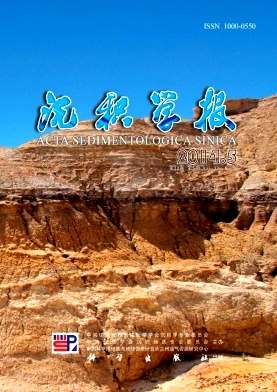|
[1]
|
付锁堂, 徐礼贵, 巩庆林, 等. 柴西南区石油地质特征及再勘探再研究的建议[J]. 中国石油勘探, 2010, 15(1):6-10[Fu Suotang, Xu ligui, Gong Qinglin, et al. Petroleum geological characteristics of the southwestern Qaidam Basin and suggestions for exploration[J]. China Petroleum Exploration, 2010, 15(1): 6-10] |
|
[2]
|
罗群, 庞雄奇. 柴达木盆地断裂特征与油气区带成藏规律[J]. 西南石油学院学报, 2003, 25(1):1-5[Luo Qun, Pang Xiongqi. Fault characteristics and hydrocarbon accumulation in Qaidam Basin[J]. Journal of Southwest Petroleum Institute, 2003, 25(1): 1-5] |
|
[3]
|
陈国民, 万云, 张培平, 等. 柴达木盆地昆北断阶带圈闭特征[J]. 西南石油大学学报:自然科学版, 2010, 32(4):39-43[Chen Guomin, Wan Yun, Zhang Peiping, et al. Trap characteristics of Kunbei fault-terrace belt in Qaidam Basin[J]. Journal of Southwest Petroleum University: Science & Technology Edition, 2010, 32(4): 39-43] |
|
[4]
|
付玲, 张子亚, 付锁堂, 等. 柴达木盆地昆北油田路乐河组沉积相及储层特征[J]. 成都理工大学学报:自然科学版, 2010, 37(5):494-500[Fu Ling, Zhang Ziya, Fu Suotang, et al. Characteristics of the sedimentary facies and reservoirs in Lulehe Formation of the Kunbei oilfield in Qaidam Basin, China[J]. Journal of Chengdu University of Technology: Science & Technology Edition, 2010, 37(5): 494-500] |
|
[5]
|
宫清顺, 寿建峰, 黄革萍, 等. 柴达木盆地昆北油田路乐河组辫状三角洲沉积特征[J]. 地质科学, 2012, 47(1)116-128[Gong Qingshun, Shou Jianfeng, Huang Geping, et al. Sedimentary characteristic of braided delta in Lulehe Formation of Kunbei oilfield in Qaidam Basin[J]. Chinese Journal of Geology, 2012, 47(1): 116-128] |
|
[6]
|
李乐, 牟中海, 汪立群, 等. 柴达木盆地昆北油田切6区E1+2碎屑岩储层特征及其控制因素[J]. 岩性油气藏, 2011, 23(4):75-80[Li Le, Mu Zhonghai, Wang Liqun, et al. Characteristics and controlling factors of E1+2 clastic reservoir in Qie 6 block of Kunbei oilfield in Qaidam Basin[J]. Lithologic Reservoirs, 2011, 23(4): 75-80] |
|
[7]
|
寿建峰, 张惠良, 斯春松, 等. 砂岩动力成岩作用[M]. 北京:石油工业出版社, 2005[Shou Jianfeng, Zhang Huiliang, Si Chunsong, et al. Dynamic Diagenesis of Sandstone[M]. Beijing: Petroleum Industry Press, 2005] |
|
[8]
|
寿建峰, 张惠良, 沈扬. 库车前陆地区吐格尔明背斜下侏罗统砂岩成岩作用及孔隙发育的控制因素分析[J]. 沉积学报, 2007, 25(6):869-875[Shou Jianfeng, Zhang Huiliang, Shen Yang. The analysis of controlling factors on sandstone diagenesis and porosity preservation of Lower Jurassic in Tugerming Anticline, Kuqa Foreland Basin[J]. Acta Sedimentologica Sinica, 2007, 25(6): 869-875] |
|
[9]
|
寿建峰, 张惠良, 沈扬, 等. 中国油气盆地砂岩储层的成岩压实机制分析[J]. 岩石学报, 2006, 22(8):2165-2170[Shou Jianfeng, Zhang Huiliang, Shen Yang, et al. Diagenetic mechanisms of sandstone reservoirs in China oil and gas-bearing basins[J]. Acta Petrologica Sinica, 2006, 22(8): 2165-2170] |
|
[10]
|
Shou Jianfeng, Si Chunsong, Wang Xin. Genesis types and diagenesis compaction mechanisms of sandstone reservoirs in dynamic environments in oil/gas basins in China[J]. Petroleum Science, 2006, 3(3): 23-31 |
|
[11]
|
刘占国, 斯春松, 寿建峰, 等. 四川盆地川中地区中下侏罗统砂岩储层异常致密成因机理[J]. 沉积学报, 2011, 29(4):744-751[Liu Zhanguo, Si Chunsong, Shou Jianfeng, et al. Origin mechanism of anomalous tightness of Middle and Lower Jurassic sandstone reservoirs in Central Sichuan Basin[J]. Acta Sedimentologica Sinica, 2011, 29(4): 744-751] |
|
[12]
|
Gaither A. A study of porosity and grain relationships in experimental sands[J].Journal of Sedimentary Petrology, 1953, 23(3): 180-195 |
|
[13]
|
Yerazunis S, Bartlett J W, Nissan A H. Packing of binary mixtures of spheres and irregular particles[J]. Nature, 1962, 195(4836): 33-35 |
|
[14]
|
Clarke R H. Reservoir properties of conglomerates and conglomeratic sandstones[J]. AAPG Bulletin, 1979, 63(5): 799-809 |
|
[15]
|
Beard D C, Weyl P K. Influence of texture on porosity and permeability of unconsolidated sand[J]. AAPG Bulletin, 1973, 57(2): 349-369 |
|
[16]
|
Houseknecht D W. Assessing the relative importance of compaction processes and cementation to reduction of porosity in sandstones[J]. AAPG Bulletin, 1987, 71(6): 633-642 |
|
[17]
|
Ehrenberg S N. Assessing the relative importance of compaction processes and cementation to reduction of porosity in sandstones: discussion; compaction and porosity evolution of Pliocene sandstones, Ventura Basin, California: discussion[J]. AAPG Bulletin, 1989, 73(10): 1274-1276 |
|
[18]
|
Lundegard P D. Sandstone porosity loss—a "big picture"view of the importance of compaction[J]. Journal of Sedimentary Petrology, 1992, 62: 250-260 |
|
[19]
|
Hooke RLeB. Processes on arid region alluvial fans[J]. Journal of Geology, 1967, 75(4): 438-460 |
|
[20]
|
Bull W B. The alluvial fan environment[J]. Progress in Physical Geography, 1977, 1(2):222-270 |
|
[21]
|
Parker G, Paola C, Whipple K X, et al. Alluvial fans formed by channelized fluvial and sheet flow. I: Theory[J]. Journal of Hydraulic Engineering, 1998, 124(10): 985-995 |
|
[22]
|
Lecce S A. The alluvial fan problem[C]//Rachocki A H, Church M. Alluvial Fans: A Field Approach. Wiley, 1990: 3-24 |
|
[23]
|
Viseras C, Fernández. Channel migration patterns and related sequences in some alluvial fan systems[J]. Sedimentary Geology, 1994, 88(3/4): 201-217 |






 DownLoad:
DownLoad: